CrowDSL: Platform for Incidents Management in a Smart City Context
Abstract
:1. Introduction
2. State of the Art
2.1. Smart City
2.2. Model-Driven Engineering
2.3. Domain-Specific Languages
2.4. Related Work
2.4.1. mPASS and WhenMyBus
2.4.2. CrowdOut
2.4.3. FixMyStreet (FMS)
2.4.4. CrowdSC
2.4.5. Comparison
- They all focus on incidents management in a city context using several technologies and approaches to achieve their objectives. For example, the use of maps is common in all solutions in order to represent the incidents or events reported by users.
- Another common feature in many projects is the fact that many of them incorporate a user profile to track the user activity in the platform.
- Except in one article, they did not test the application with the end-user, who is the most important part. These users have to use the application to send the problem in the cities. The other one did, but they did not describe everything because of confidentiality, and the rest are opinions about the application.
- It includes many of these features.
- We have evaluated the platform with users. Then, we have obtained results to know the opinion of the people who would have to use the DSL, which has been developed for them. Furthermore, we have used an evaluation that was used in other articles.
3. Case of Study: CrowDSL
3.1. Architecture
3.2. CrowDSL: The Domain-Specific Language
- A—Palette of components. With this tool, users drag and drop components to the editor and define relationships among elements.
- B—Editor. This element allows users to watch the incident structure they are reporting at that time.
- C—Properties. This panel shows all properties of the component selected in the editor. This way, users can provide values to entities attributes.
- D—Log. This element shows the feedback to users. Once incidents are sent, they can contain validation errors. These errors are displayed through this component.
- E—Incident representation. Once an incident is validated, a JSON format representation of it is shown in this box to check all data and structure specified.
3.3. Incidents Validation Process
4. Evaluation and Discussion
4.1. Methodology
4.2. Results
- D3, D5 and D9 have the highest minimum, so the vast majority of people agreed with those ones, at least.
- D1, D3, D5, D6 and D9 have the highest median, so we can deduct that the users agreed with these declarations.
- D3, D5 and D9 have a range of 1. The meaning of this is that the participants have almost the same opinion in these declarations. On the other hand, D8 has a range of 5, the highest. This means that in D8, there exists a big difference between the answers of the participants. Here, we can find answers from strongly disagree to strongly agree.
- All declarations have a high maximum, with a value of 5 (strong agreement).
- The mode is between 4 (agree) and 5 (strongly agree) in 8 of the 10 declarations, so mostly, users agreed or strongly agreed with those statements. On the other hand, we can find 2 declarations with a mode of 2 in D8 and 3 in D4. Then, the most chosen answer in D8 was disagree and in D4 was neutral.
- The negative side of this study is shown in D8, where users estimate that the log errors of the application are not understandable enough. This is why the mode and median have a value of 2 (disagreement). Besides, according to D4, the logical structure could be improved because users are between neutral and agree.
- Users strongly agree in a very high percentage in D3 (90%), highlighting the facility to provide data to language attributes of elements. Then, a total of 18 users out of 20 strongly agreed with D3, and 2 out of 20 agreed.
- In D5, 85% of users (14 out of 20) prefer this reporting methodology rather than sending incidents in text mode. In total, 4 users agreed and 1 chose neutral.
- D9 has very good acceptation because 75% of the users strongly agree with it and the other 25% agree.
- Half of all users (50%) agreed in being satisfied with the platform, and 45% strongly agree with this statement.
- D8 is the worst rated because 70% of the users strongly disagree.
5. Conclusions
6. Future Work
- Gather data to make statistics analysis about the location of the incidents.
- Statistics analysis of the application logs to improve user interactions and the usability. Besides, it could do a usability study about the current interface.
- Add new elements to the DSL: some users expressed that they believe that other elements could be useful for some cases. For instance, one of them could be the element ’Others’ to try to represent different entities that currently have no representation.
- Extend the DSL: currently, the incidents are internally represented using JSON-LD. An option could be to add functionalities to allow searching and filtering of the stored data.
- Data scale tests: carry out load tests and other types of tests to obtain concrete values about the data scale the language can handle.
Author Contributions
Funding
Institutional Review Board Statement
Informed Consent Statement
Conflicts of Interest
Abbreviations
| DSL | Domain-Specific Language |
| FMS | FixMyStreet |
| IT | Information Technology |
| IoT | Internet of Things |
| MDE | Model-Driven Engineering |
| MOCSL | Midgar Object Creation Specific Language |
| MOISL | Midgar Object Interconnection Specific Language |
| MUCSL | Midgar Use Case Specification Language |
| NFC | Near Field Communication |
| POI | Point of Interest |
| RFID | Radio Frequency Identification |
| XMI | XML Metadata Interchange |
| XML | eXtensible Markup Language |
| XPDML | eXtensible Process Definition Markup Language |
References
- Council, N. Disruptive Civil Technologies: Six Technologies with Potential Impacts on Us Interests Out to 2025. 2008. Available online: https://irp.fas.org/nic/disruptive.pdf (accessed on 16 September 2021).
- Property, I.; Informatics, O. Eight Great Technologies The Internet of Things. Available online: https://assets.publishing.service.gov.uk/government/uploads/system/uploads/attachment_data/file/343879/informatics-internet.pdf (accessed on 16 September 2021).
- Walport, M. The Internet of Things: Making the Most of the Second Digital Revolution; UK Government Chief Scientific Adviser. 2014. Available online: https://www.oxfordmartin.ox.ac.uk/publications/the-internet-of-things-making-the-most-of-the-second-digital-revolution/ (accessed on 16 September 2021).
- Meana-Llorián, D.; García, C.G.; Pelayo G-Bustelo, C.; Cueva-Lovelle, J.M. BILROST: Handling Actuators of the Internet of Things through Tweets on Twitter using a Domain- Specific Language. Int. J. Interact. Multimed. Artif. Intell. 2021, 6. [Google Scholar] [CrossRef]
- Yu, R.; Kilari, V.T.; Xue, G.; Yang, D. Load Balancing for Interdependent IoT Microservices. In Proceedings of the IEEE INFOCOM 2019–IEEE Conference on Computer Communications, Paris, France, 29 April–2 May 2019; pp. 298–306. [Google Scholar] [CrossRef]
- Miorandi, D.; Sicari, S.; Pellegrini, F.D.; Chlamtac, I. Ad Hoc Networks Internet of things: Vision, applications and research challenges. Ad Hoc Netw. 2012, 10, 1497–1516. [Google Scholar] [CrossRef] [Green Version]
- Jin, W.; Xu, R.; You, T.; Hong, Y.G.; Kim, D. Secure Edge Computing Management Based on Independent Microservices Providers for Gateway-Centric IoT Networks. IEEE Access 2020, 8, 187975–187990. [Google Scholar] [CrossRef]
- Cabrera, E.; Cárdenas, P.; Cedillo, P.; Pesántez-Cabrera, P. Towards a Methodology for creating Internet of Things (IoT) Applications based on Microservices. In Proceedings of the 2020 IEEE International Conference on Services Computing (SCC), Honolulu, HI, USA, 18–20 September 2020; pp. 472–474. [Google Scholar] [CrossRef]
- Atzori, L.; Iera, A.; Morabito, G. The Internet of Things: A survey. Comput. Netw. 2010, 54, 2787–2805. [Google Scholar] [CrossRef]
- Benouaret, K.; Valliyur-Ramalingam, R.; Charoy, F.; Karim Benouaret, R.V.R.F.C. CrowdSC: Building Smart Cities with Large Scale Citizen Participation. IEEE Internet Comput. 2013, 17, 57–63. [Google Scholar] [CrossRef] [Green Version]
- King, S.F.; Brown, P. Fix My Street or Else: Using the Internet to Voice Local Public Service Concerns. Comput. Soc. 2007, 72–80. [Google Scholar] [CrossRef]
- Baykurt, B. Redefining Citizenship and Civic Engagement: Political Values Embodied in FixMyStreet.com; Anais do AoIR—Association of Internet Research: Seattle, WA, USA, 2011; pp. 1–18. [Google Scholar]
- González García, C.; Meana Llorián, D.; Pelayo García-Bustelo, B.C.; Cueva Lovelle, J.M. A review about smart objects, sensors, and actuators. Int. J. Interact. Multimed. Artif. Intell. 2017, 4, 7–10. [Google Scholar] [CrossRef]
- Haller, S. The Things in the Internet of Things. In Proceedings of the Internet of Things 2010, Tokyo, Japan, 1 December 2010. [Google Scholar]
- Bello, O.; Zeadally, S.; Member, S. Intelligent Device-to-Device Communication in the Internet of Things. IEEE Syst. J. 2016, 10, 1172–1182. [Google Scholar] [CrossRef]
- Pitatzis, S.; Drosos, N.; Goumopoulos, C.; Kameas, A. AmIoT: A Microservices-based IoT Platform to Orchestrate AmI Environments. In Proceedings of the 2020 16th International Conference on Intelligent Environments (IE), Madrid, Spain, 20–23 July 2020; pp. 21–28. [Google Scholar] [CrossRef]
- Chan, M.; Campo, E.; Estève, D.; Fourniols, J.Y. Maturitas Smart homes—Current features and future perspectives. Maturitas 2009, 64, 90–97. [Google Scholar] [CrossRef] [PubMed]
- Giffinger, R.; Fertner, C.; Kramar, H.; Meijers, E. City-ranking of European Medium-Sized Cities. pp. 1–12. Available online: http://www.smart-cities.eu/download/city_ranking_final.pdf (accessed on 16 September 2021).
- Council, N.R.D. What Are Smarter Cities? Available online: http://smartercities.nrdc.org/ (accessed on 16 September 2021).
- Patrice, R. Creating “The Smart City”. 2008. Available online: https://books.google.co.jp/books/about/Creating_the_Smart_City.html?id=UzjADAEACAAJ&redir_esc=y (accessed on 16 September 2021).
- Akande, A.; Cabral, P.; Gomes, P.; Casteleyn, S. The Lisbon ranking for smart sustainable cities in Europe. Sustain. Cities Soc. 2019, 44, 475–487. [Google Scholar] [CrossRef]
- United Nations. Population Distribution, Urbanization, Internal Migration and Development: An International Perspective; United Nations: New York, NY, USA, 2011. [Google Scholar]
- Bibri, S.E. The IoT for smart sustainable cities of the future: An analytical framework for sensor-based big data applications for environmental sustainability. Sustain. Cities Soc. 2018, 38, 230–253. [Google Scholar] [CrossRef]
- Kummitha, R.K.R.; Crutzen, N. How do we understand smart cities? An evolutionary perspective. Cities 2017, 67, 43–52. [Google Scholar] [CrossRef]
- González García, C.; Espada, J.P.; Valdez, E.R.N.; García-Díaz, V. Midgar: Domain-Specific Language to Generate Smart Objects for an Internet of Things Platform. In Proceedings of the 2014 Eighth International Conference on Innovative Mobile and Internet Services in Ubiquitous Computing, Birmingham, UK, 2–4 July 2014; pp. 352–357. [Google Scholar] [CrossRef]
- Garcia, C.G.; Meana-Llorian, D.; Garcia-Diaz, V.; Jimenez, A.C.; Anzola, J.P. Midgar: Creation of a Graphic Domain-Specific Language to Generate Smart Objects for Internet of Things Scenarios Using Model-Driven Engineering. IEEE Access 2020, 8, 141872–141894. [Google Scholar] [CrossRef]
- García, C.G.; G-Bustelo, B.C.P.; Espada, J.P.; Cueva-Fernandez, G. Midgar: Generation of heterogeneous objects interconnecting applications. A Domain Specific Language proposal for Internet of Things scenarios. Comput. Netw. 2014, 64, 143–158. [Google Scholar] [CrossRef]
- González García, C.; Zhao, L.; García-Díaz, V. A User-Oriented Language for Specifying Interconnections Between Heterogeneous Objects in the Internet of Things. IEEE Internet Things J. 2019, 6, 3806–3819. [Google Scholar] [CrossRef] [Green Version]
- García Díaz, V.; Fernandez, H.; Palacios-González, E.; Pelayo García-Bustelo, B.; Sanjuán, O.; Cueva Lovelle, J. Automated code generation support for BI with MDA TALISMAN. Int. J. Artif. Intell. Interact. Multimed. 2009, 1, 87–93. [Google Scholar]
- Kolovos, D.S.; Paige, R.F.; Kelly, T.; Polack, F.A.C. Requirements for Domain-Specific Languages. pp. 1–4. Available online: http://www-users.cs.york.ac.uk/~tpk/req_dsls.pdf (accessed on 16 September 2021).
- Mernik, M.; Heering, J.A.N.; Sloane, A.M. When and How to Develop Domain-Specific Languages AND. Acm Comput. Surv. 2005, 37, 316–344. [Google Scholar] [CrossRef] [Green Version]
- Deursen, A.V.; Klint, P.; Visser, J. Domain-Specific Languages: An Annotated Bibliography. ACM Sigplan Not. 2000, 35, 26–36. [Google Scholar] [CrossRef] [Green Version]
- Washburn, D.; Sindhu, U.; Balaouras, S.; Dines, R.A.; Hayes, N.M.; Nelson, L.E. Helping CIOs Understand “Smart City” Initiatives. 2010. Available online: https://s3-us-west-2.amazonaws.com/itworldcanada/archive/Themes/Hubs/Brainstorm/forrester_help_cios_smart_city.pdf (accessed on 16 September 2021).
- Science, R.; Studies, M. Smart Cities Ranking of European Medium-Sized Cities. 2007. Available online: http://www.smart-cities.eu/download/smart_cities_final_report.pdf (accessed on 16 September 2021).
- Vienna University of Technology. European Smart Cities; Vienna University of Technology: Vienna, Austria, 2015. [Google Scholar]
- Nam, T.; Pardo, T.A. Conceptualizing Smart City with Dimensions of Technology, People, and Institutions. In Proceedings of the 12th Annual International Digital Government Research Conference: Digital Government Innovation in Challenging Times, College Park, MD, USA, 12–15 June 2011; pp. 282–291. [Google Scholar] [CrossRef]
- Selic, B. Model-driven development of real-time software using OMG standards. In Proceedings of the Sixth IEEE International Symposium on Object-Oriented Real-Time Distributed Computing, Hokkaido, Japan, 16 May 2003; pp. 4–6. [Google Scholar] [CrossRef]
- Hailpern, B.; Tarr, P. Model-driven development: The good, the bad, and the ugly. IBM Syst. J. 2006, 45, 451–461. [Google Scholar] [CrossRef]
- Schmidt, D.C. Guest Editor’s Introduction: Model-Driven Engineering. Computer 2006, 39, 25–31. [Google Scholar] [CrossRef]
- Deursen, A.V.; Klint, P. Domain-Specific Language Design Requires Feature Descriptions. J. Comput. Inf. Technol. 2002, 10, 1–17. [Google Scholar] [CrossRef] [Green Version]
- Mirri, S.; Prandi, C.; Salomoni, P.; Callegati, F.; Campi, A. On combining crowdsourcing, sensing and open data for an accessible smart city. In Proceedings of the 2014 8th International Conference on Next Generation Mobile Applications, Services and Technologies, NGMAST 2014, Oxford, UK, 10–12 September 2014; pp. 294–299. [Google Scholar] [CrossRef]
- Aubry, E.; Silverston, T.; Lahmadi, A.; Festor, O. CrowdOut: A mobile crowdsourcing service for road safety in digital cities. In Proceedings of the 2014 IEEE International Conference on Pervasive Computing and Communication Workshops, PERCOM WORKSHOPS 2014, Budapest, Hungary, 24–28 March 2014; pp. 86–91. [Google Scholar] [CrossRef]
- OMG. About the XML Metadata Interchange Specification Version 2.5.1. 2015. Available online: https://www.omg.org/spec/XMI/2.5.1/About-XMI/ (accessed on 16 September 2021).
- Groves, R.; Fowler, F.; Couper, M.; Lepkowski, J.; Singer, E.; Tourangeau, R. Survey Methodology, 2nd ed.; Wiley-Interscience: New York, NY, USA, 2009; p. 496. [Google Scholar]
- Likert, R. A technique for the measurement of attitudes. Arch. Psychol. 1932. Available online: https://psycnet.apa.org/record/1933-01885-001 (accessed on 16 September 2021).
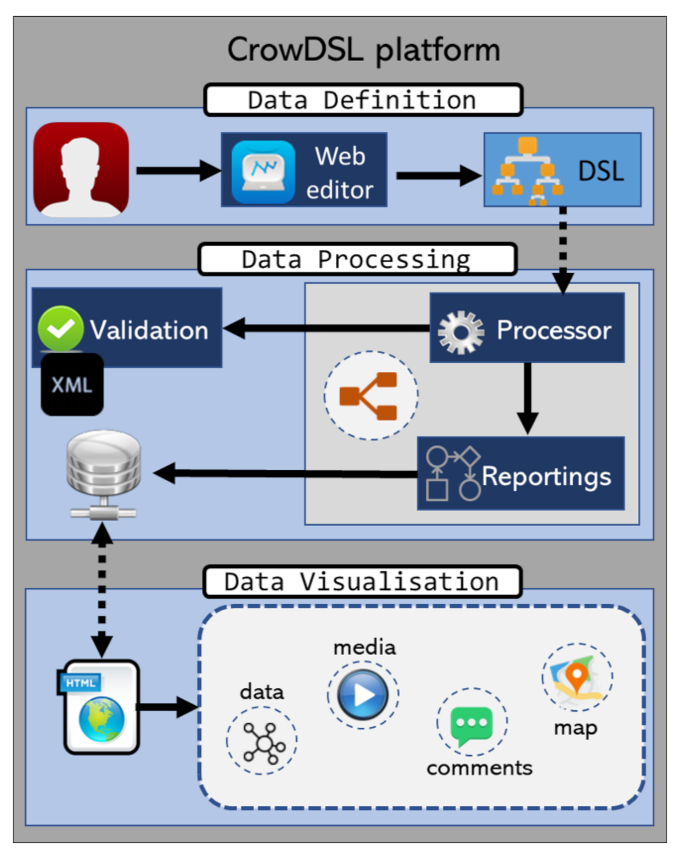
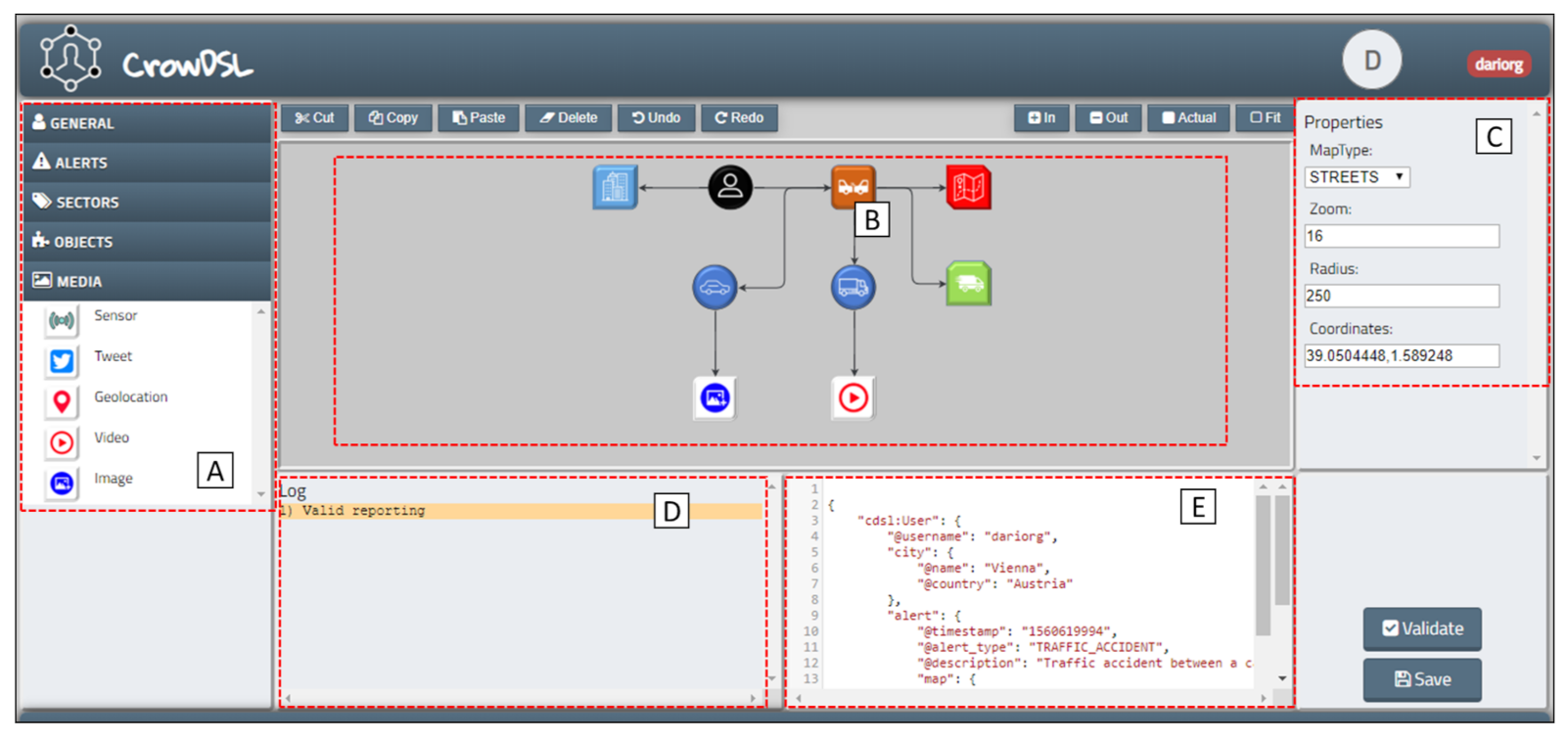
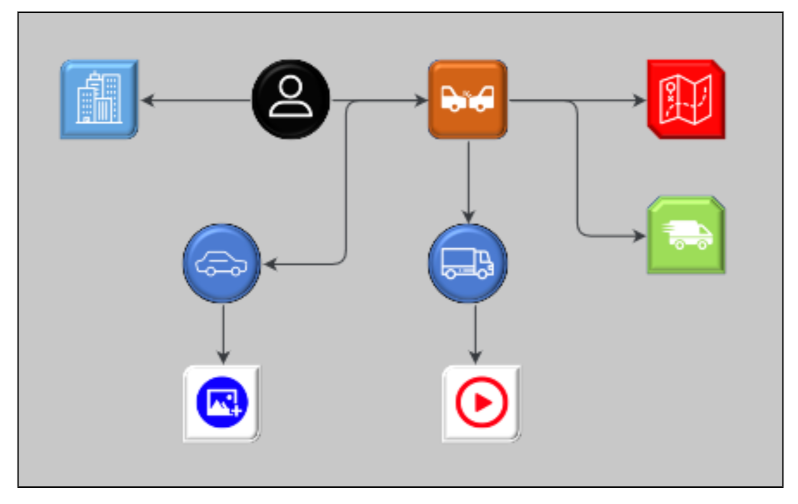
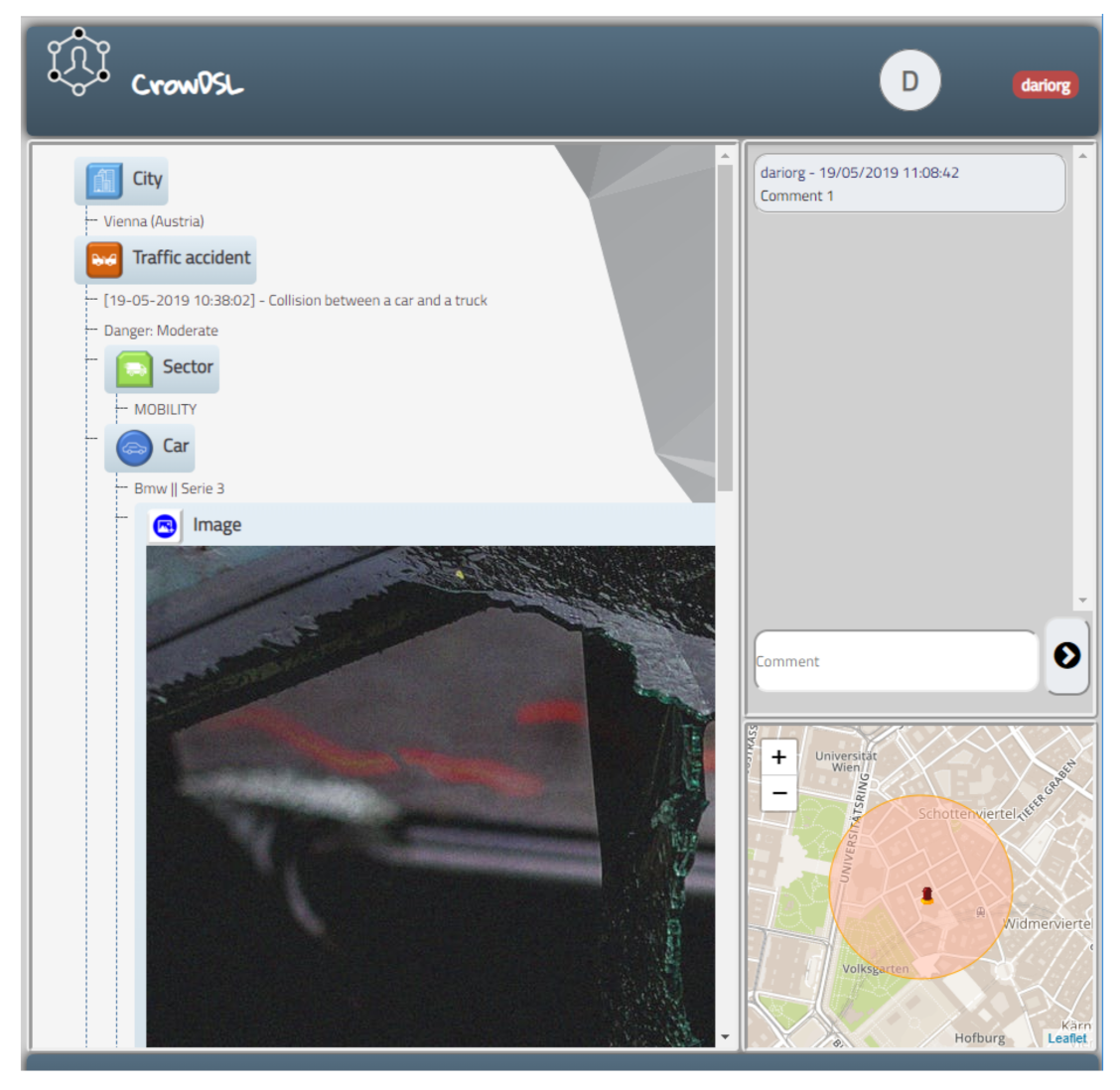
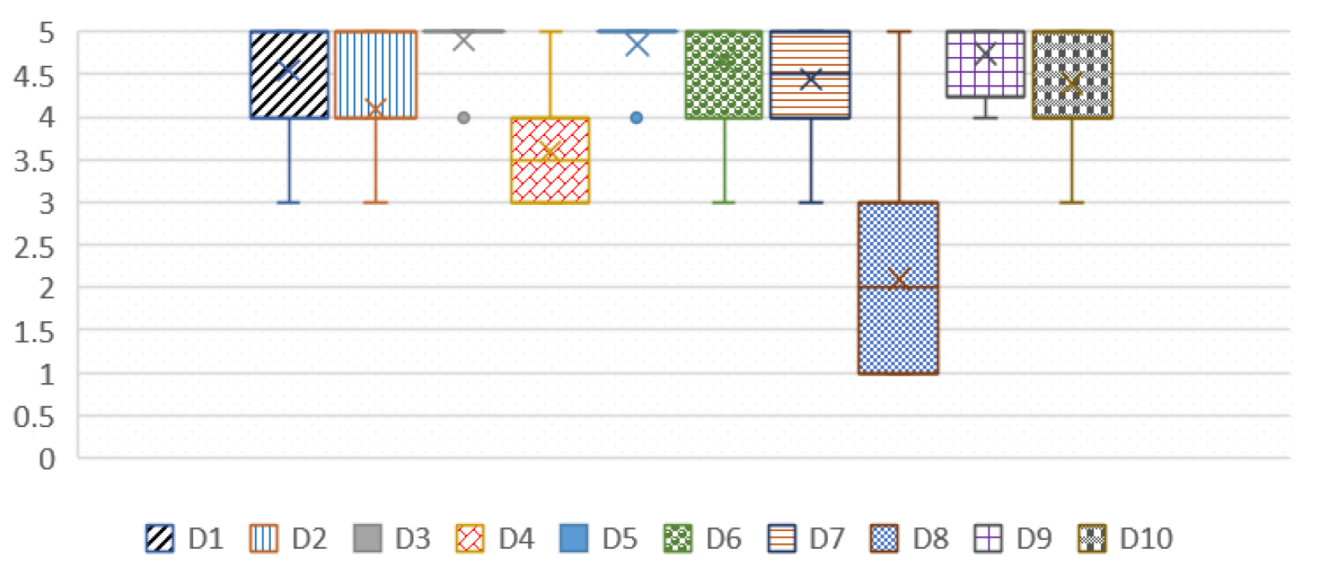
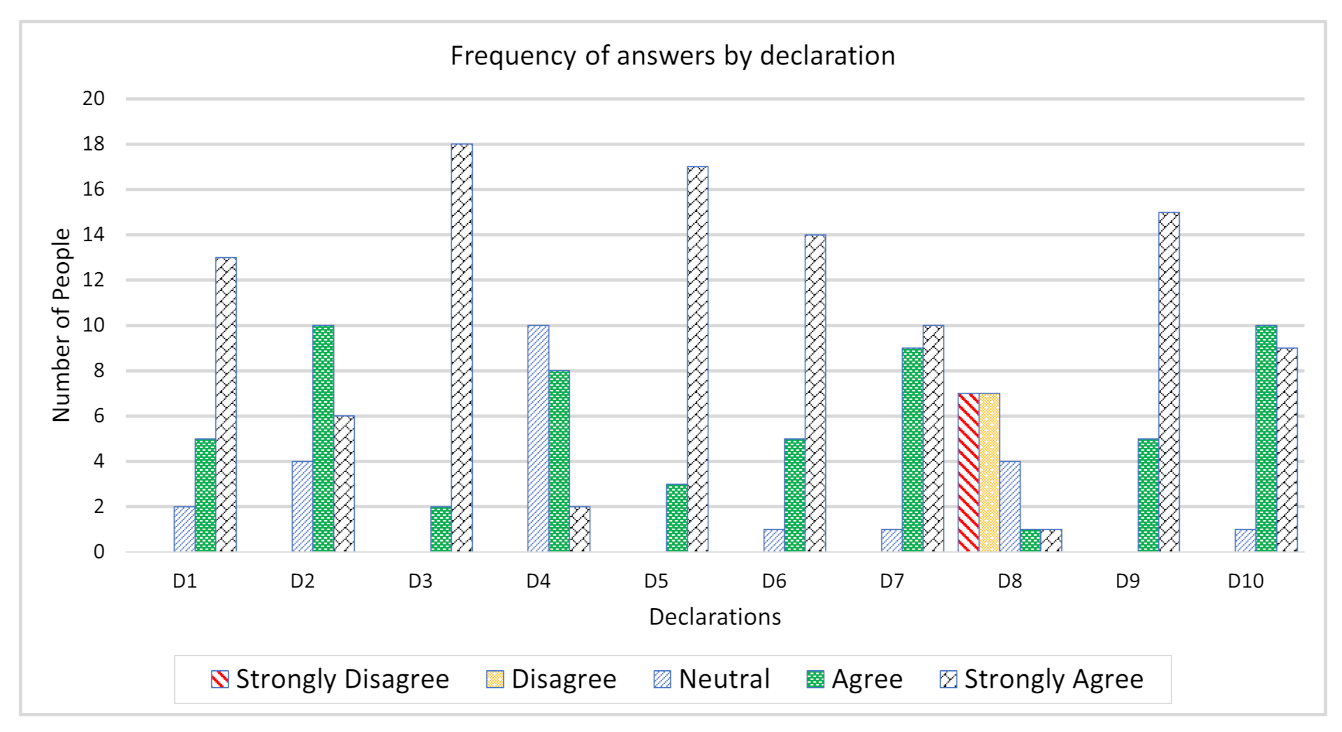
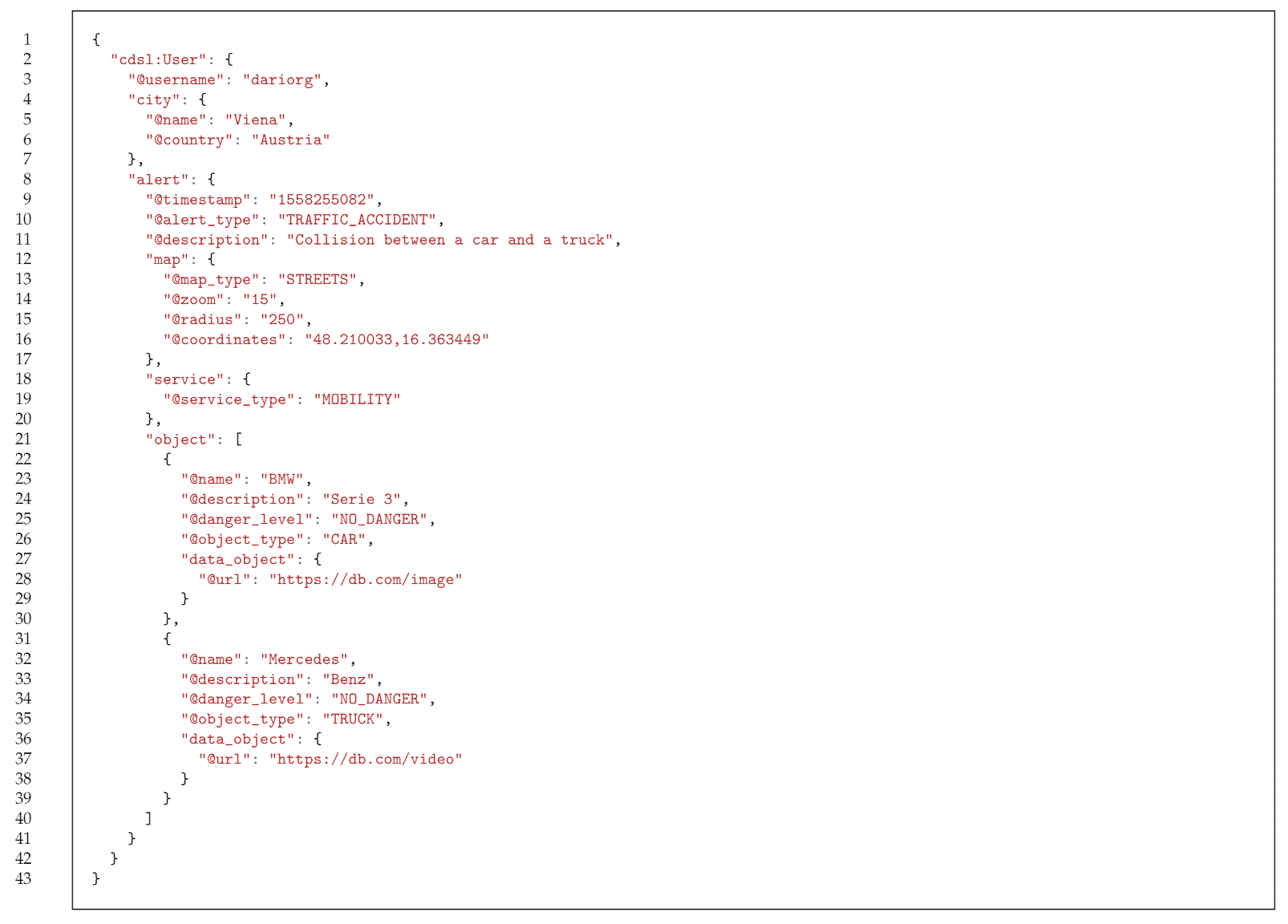
| Abstract Syntax | Concrete Syntax |
|---|---|
| User |  |
| City |  |
| Map |  |
| Fire (Alert) |  |
| Person (Object) |  |
| Mobility (Sector) |  |
| Image (Media) |  |
| Level/Type | Beginner | Middle-Level | Professional |
|---|---|---|---|
| IT | 4 | 7 | 9 |
| IoT | 13 | 5 | 2 |
| D/U | D1 | D2 | D3 | D4 | D5 | D6 | D7 | D8 | D9 | D10 |
|---|---|---|---|---|---|---|---|---|---|---|
| U1 | 4 | 3 | 5 | 3 | 5 | 5 | 5 | 2 | 5 | 4 |
| U2 | 5 | 4 | 5 | 4 | 5 | 5 | 4 | 3 | 5 | 5 |
| U3 | 5 | 4 | 5 | 3 | 5 | 5 | 5 | 1 | 5 | 4 |
| U4 | 5 | 4 | 5 | 3 | 5 | 5 | 5 | 2 | 5 | 4 |
| U5 | 5 | 3 | 5 | 4 | 4 | 5 | 5 | 2 | 4 | 4 |
| U6 | 4 | 4 | 5 | 3 | 5 | 3 | 4 | 1 | 4 | 4 |
| U7 | 5 | 5 | 5 | 3 | 5 | 4 | 4 | 0 | 5 | 5 |
| U8 | 3 | 5 | 5 | 3 | 5 | 5 | 4 | 2 | 5 | 3 |
| U9 | 5 | 5 | 4 | 5 | 5 | 5 | 5 | 3 | 4 | 4 |
| U10 | 5 | 4 | 5 | 3 | 5 | 5 | 5 | 1 | 4 | 5 |
| U11 | 5 | 5 | 4 | 3 | 5 | 5 | 5 | 0 | 4 | 5 |
| U12 | 4 | 4 | 5 | 4 | 5 | 5 | 5 | 3 | 5 | 5 |
| U13 | 3 | 3 | 5 | 4 | 5 | 4 | 4 | 4 | 5 | 4 |
| U14 | 5 | 3 | 5 | 3 | 5 | 4 | 4 | 5 | 5 | 4 |
| U15 | 4 | 4 | 5 | 3 | 4 | 4 | 4 | 1 | 5 | 5 |
| U16 | 4 | 5 | 5 | 4 | 4 | 4 | 3 | 2 | 5 | 4 |
| U17 | 5 | 4 | 5 | 5 | 5 | 5 | 4 | 2 | 5 | 4 |
| U18 | 5 | 4 | 5 | 4 | 5 | 5 | 4 | 2 | 5 | 5 |
| U19 | 5 | 5 | 5 | 4 | 5 | 5 | 5 | 3 | 5 | 5 |
| U20 | 5 | 4 | 5 | 4 | 5 | 5 | 5 | 1 | 5 | 5 |
| # | Declaration |
|---|---|
| D1 | The elements of the language are well defined and their purpose are understood by users. |
| D2 | The elements of the language are adequate to model any type of incidence. |
| D3 | It is easy to specify the values for the attributes of elements (level of danger, description, ...). |
| D4 | The logical structure of the relationships between entities is understood. |
| D5 | You prefer this methodology rather than sending the incidents in text mode |
| D6 | The editor elements are well structured and it is easy to work with it. |
| D7 | The web editor is useful for modelling city incidents. |
| D8 | The user understands the log errors of the application. |
| D9 | This work would be useful in a Smart City. |
| D10 | The degree of satisfaction with platform is high. |
| D1 | D2 | D3 | D4 | D5 | D6 | D7 | D8 | D9 | D10 | |
|---|---|---|---|---|---|---|---|---|---|---|
| Min | 3 | 3 | 4 | 3 | 4 | 3 | 3 | 0 | 4 | 3 |
| Quartile 1 | 4 | 4 | 5 | 3 | 5 | 4 | 4 | 1 | 4.25 | 4 |
| Median | 5 | 4 | 5 | 3.5 | 5 | 5 | 4.5 | 2 | 5 | 4 |
| Quartile 3 | 5 | 5 | 5 | 4 | 5 | 5 | 5 | 3 | 5 | 5 |
| Max | 5 | 5 | 5 | 5 | 5 | 5 | 5 | 5 | 5 | 5 |
| Range | 2 | 2 | 1 | 2 | 1 | 2 | 2 | 5 | 1 | 2 |
| Inter Qrt.-Range | 1 | 1 | 0 | 1 | 0 | 1 | 1 | 2 | 0.75 | 1 |
| Mode | 5 | 4 | 5 | 3 | 5 | 5 | 5 | 2 | 5 | 4 |
| Declaration | Strongly Disagree | Disagree | Neutral | Agree | Strongly Agree | |
|---|---|---|---|---|---|---|
| D1 | # | 0 | 0 | 2 | 5 | 13 |
| % | 0% | 0% | 10% | 25% | 65% | |
| D2 | # | 0 | 0 | 4 | 10 | 6 |
| % | 0% | 0% | 20% | 50% | 30% | |
| D3 | # | 0 | 0 | 0 | 2 | 18 |
| % | 0% | 0% | 0% | 10% | 90% | |
| D4 | # | 0 | 0 | 10 | 8 | 2 |
| % | 0% | 0% | 50% | 40% | 10% | |
| D5 | # | 0 | 0 | 0 | 3 | 17 |
| % | 0% | 0% | 0% | 15% | 85% | |
| D6 | # | 0 | 0 | 1 | 5 | 14 |
| % | 0% | 0% | 5% | 25% | 70% | |
| D7 | # | 0 | 0 | 1 | 9 | 10 |
| % | 0% | 0% | 5% | 45% | 50% | |
| D8 | # | 7 | 7 | 4 | 1 | 1 |
| % | 35% | 35% | 20% | 5% | 5% | |
| D9 | # | 0 | 0 | 0 | 5 | 15 |
| % | 0% | 0% | 0% | 25% | 75% | |
| D10 | # | 0 | 0 | 1 | 10 | 9 |
| % | 0% | 0% | 5% | 50% | 45% | |
Publisher’s Note: MDPI stays neutral with regard to jurisdictional claims in published maps and institutional affiliations. |
© 2021 by the authors. Licensee MDPI, Basel, Switzerland. This article is an open access article distributed under the terms and conditions of the Creative Commons Attribution (CC BY) license (https://creativecommons.org/licenses/by/4.0/).
Share and Cite
Rodríguez-García, D.; García-Díaz, V.; González García, C. CrowDSL: Platform for Incidents Management in a Smart City Context. Big Data Cogn. Comput. 2021, 5, 44. https://doi.org/10.3390/bdcc5030044
Rodríguez-García D, García-Díaz V, González García C. CrowDSL: Platform for Incidents Management in a Smart City Context. Big Data and Cognitive Computing. 2021; 5(3):44. https://doi.org/10.3390/bdcc5030044
Chicago/Turabian StyleRodríguez-García, Darío, Vicente García-Díaz, and Cristian González García. 2021. "CrowDSL: Platform for Incidents Management in a Smart City Context" Big Data and Cognitive Computing 5, no. 3: 44. https://doi.org/10.3390/bdcc5030044
APA StyleRodríguez-García, D., García-Díaz, V., & González García, C. (2021). CrowDSL: Platform for Incidents Management in a Smart City Context. Big Data and Cognitive Computing, 5(3), 44. https://doi.org/10.3390/bdcc5030044








